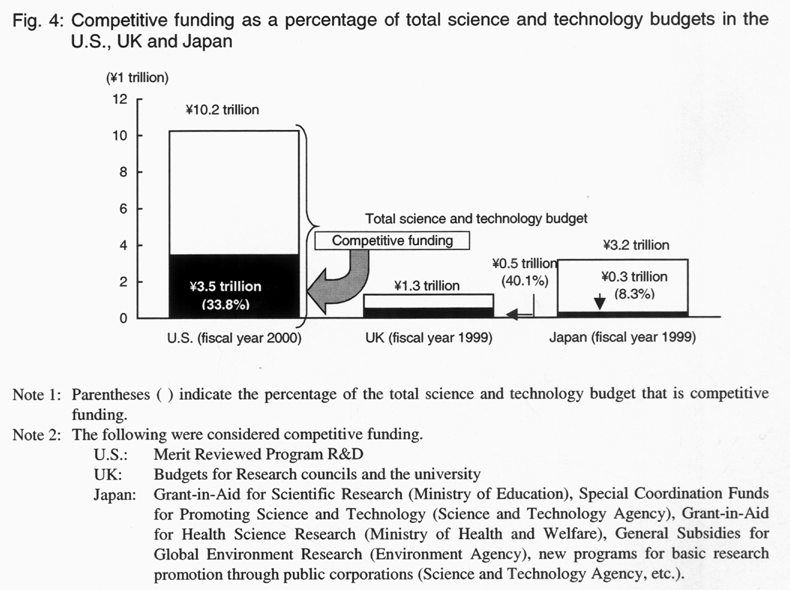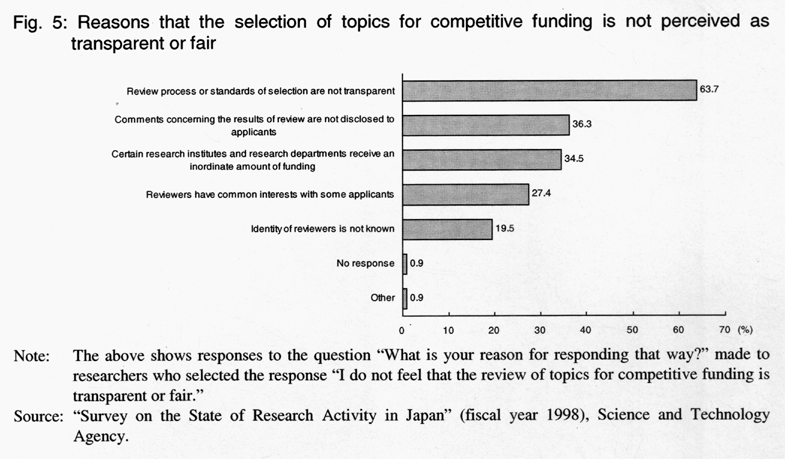| Home > Policy > White Paper, Notice, Announcement > White Paper > Annual Report on the Promotion of Science and Technology 1999 > Part1 Chapter2 Section1 3 | ||
![]() Persons with postgraduate degrees or higher are becoming the
primary players of research and development. Despite expansion in the number
of persons with postgraduate degree, a large gap with the U.S. persists. Measures
are required to secure and train enough number of talented researchers to satisfy
needs in each research field.
Persons with postgraduate degrees or higher are becoming the
primary players of research and development. Despite expansion in the number
of persons with postgraduate degree, a large gap with the U.S. persists. Measures
are required to secure and train enough number of talented researchers to satisfy
needs in each research field.
![]() Researchers are beginning to view postdoctoral research experience
as important to their careers as researchers, although societal recognition of
this "postdoctor" is by no means firmly established. Many private enterprises
responded to the survey that they have no plans to employ either doctoral or
postdoctoral researchers.
Researchers are beginning to view postdoctoral research experience
as important to their careers as researchers, although societal recognition of
this "postdoctor" is by no means firmly established. Many private enterprises
responded to the survey that they have no plans to employ either doctoral or
postdoctoral researchers.
![]() The dissemination of the achievements of such researchers
is needed to enable these researchers to find new employment in research. This
is needed to encourage research institutes to hire doctoral and postdoctoral
researchers more actively, to raise the status of such researchers, and encourage
students to pursue more-advanced research experience, thereby raising the overall
quality of researchers.
The dissemination of the achievements of such researchers
is needed to enable these researchers to find new employment in research. This
is needed to encourage research institutes to hire doctoral and postdoctoral
researchers more actively, to raise the status of such researchers, and encourage
students to pursue more-advanced research experience, thereby raising the overall
quality of researchers.
![]() Despite expanded budget for new measures for hiring of research
assistants, reducing the number of assistants employed by the program of reductions
of public servant and attrition with retirement, etc., have prevented to attain
the goal for number of research assistants per researcher from being reached.
As the duties of research assistants are expanded to include the works concerning
application of patents and competitive funding, research support functions must
be strengthened and expanded to satisfy these diverse needs.
Despite expanded budget for new measures for hiring of research
assistants, reducing the number of assistants employed by the program of reductions
of public servant and attrition with retirement, etc., have prevented to attain
the goal for number of research assistants per researcher from being reached.
As the duties of research assistants are expanded to include the works concerning
application of patents and competitive funding, research support functions must
be strengthened and expanded to satisfy these diverse needs.
![]() Talented foreign researchers, who could be important research
assets, should be promoted to employ in order to secure world-caliber intellectual
talent on an international scale. Such researchers' firm establishment in Japan's
research community should also be promoted. This will not only improve Japan's
R&D potential directly, but will also help stimulate Japanese researchers
intellectually.
Talented foreign researchers, who could be important research
assets, should be promoted to employ in order to secure world-caliber intellectual
talent on an international scale. Such researchers' firm establishment in Japan's
research community should also be promoted. This will not only improve Japan's
R&D potential directly, but will also help stimulate Japanese researchers
intellectually.
![]() The competitive research fund is increasing in Japan, examples
being the Grant-in-Aid for Scientific Research and the Special Coordination Funds
for Promoting Science and Technology (SCF). Nonetheless, competitive funding
accounts for 30% of total R&D budgets in the U.S. and the UK but only about
10% in Japan ( Fig. 4 ).
The competitive research fund is increasing in Japan, examples
being the Grant-in-Aid for Scientific Research and the Special Coordination Funds
for Promoting Science and Technology (SCF). Nonetheless, competitive funding
accounts for 30% of total R&D budgets in the U.S. and the UK but only about
10% in Japan ( Fig. 4 ).

![]() Research environments must be made even more competitive by
increasing the proportion of competitive research funding and evaluators who
review applications for such funding should be increased and justified their
evaluation.
Research environments must be made even more competitive by
increasing the proportion of competitive research funding and evaluators who
review applications for such funding should be increased and justified their
evaluation.
![]() Nearly 30% of researchers responding to a survey believe that
the review process is not transparent or fair, while approximately 40% stated
that comments regarding the results of review are not made known to the applicants
themselves ( Fig. 5 ).
Review procedures for competitive research funding that explain to unsuccessful
applicants why they were turned down will provide those researchers will important
intellectual lessons, motivating them and improving their abilities. Thus, competitive
funding must be improved qualitatively by increasing the number of evaluators,
providing increased funding for evaluators, and by notifying unsuccessful applicants
of the reasons for being passed over.
Nearly 30% of researchers responding to a survey believe that
the review process is not transparent or fair, while approximately 40% stated
that comments regarding the results of review are not made known to the applicants
themselves ( Fig. 5 ).
Review procedures for competitive research funding that explain to unsuccessful
applicants why they were turned down will provide those researchers will important
intellectual lessons, motivating them and improving their abilities. Thus, competitive
funding must be improved qualitatively by increasing the number of evaluators,
providing increased funding for evaluators, and by notifying unsuccessful applicants
of the reasons for being passed over.

![]() One of the most important prerequisites for actualizing competitive
R&D environments is impartial R&D evaluation and the reflecting of evaluation
results in resource allocation and compensation, for instance.
One of the most important prerequisites for actualizing competitive
R&D environments is impartial R&D evaluation and the reflecting of evaluation
results in resource allocation and compensation, for instance.
![]() In addition to raising the quality of evaluation by broadening
the pool of evaluators, it is also necessary to enhance evaluation by improving
and developing innovative evaluation techniques and by reflecting the results
of evaluation in resource allocation.
In addition to raising the quality of evaluation by broadening
the pool of evaluators, it is also necessary to enhance evaluation by improving
and developing innovative evaluation techniques and by reflecting the results
of evaluation in resource allocation.
![]() Facilitating the transfer the findings of governmental and
quasi governmental research to the society is an important issue in science and
technology policy.
Facilitating the transfer the findings of governmental and
quasi governmental research to the society is an important issue in science and
technology policy.
![]() As of April 16, 1999, six technology transfer office had been
approved under the Law to Promote the Transfer to the Private Sector of the Results
of Technological Research at Universities and Other Institutions.
As of April 16, 1999, six technology transfer office had been
approved under the Law to Promote the Transfer to the Private Sector of the Results
of Technological Research at Universities and Other Institutions.
![]() With respect to patent and other rights resulting from joint
or contracted research, government agencies are working out the details of contracts
and agreements that permit by priority licensing by the institutions involved
in the joint or contracted research. Between 1995 and 1998, the number of licenses
granted has increased substantially.
With respect to patent and other rights resulting from joint
or contracted research, government agencies are working out the details of contracts
and agreements that permit by priority licensing by the institutions involved
in the joint or contracted research. Between 1995 and 1998, the number of licenses
granted has increased substantially.
![]() To expedite the transfer of research results, government agencies
have prepared the standards for permitting the concurrent employment of researchers
in the public sector, and have also improved the rules under which patent rights
revert to the individual. The result has been an increase in the number of permission
of concurrent employment at national research institutes and in the number of
patent rights reverted to the researchers.
To expedite the transfer of research results, government agencies
have prepared the standards for permitting the concurrent employment of researchers
in the public sector, and have also improved the rules under which patent rights
revert to the individual. The result has been an increase in the number of permission
of concurrent employment at national research institutes and in the number of
patent rights reverted to the researchers.
![]() To take such efforts even further, universities, national
research institutes, special corporations and regional research institutions
founded by local governments must strive to be seen by the private sectors as
a rich source of knowledge. Other important issues that must now be addressed
include promoting ventures based on the results of research at universities or
national research institutes, assigning persons judicious enough to assess both
private enterprises and, universities and national research institutes. It is
also important to foster the entrepreneurial spirit among university students.
To take such efforts even further, universities, national
research institutes, special corporations and regional research institutions
founded by local governments must strive to be seen by the private sectors as
a rich source of knowledge. Other important issues that must now be addressed
include promoting ventures based on the results of research at universities or
national research institutes, assigning persons judicious enough to assess both
private enterprises and, universities and national research institutes. It is
also important to foster the entrepreneurial spirit among university students.
| Back to Top | MEXT HOME |